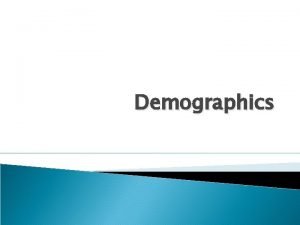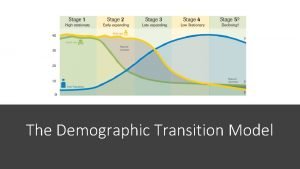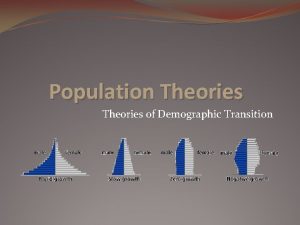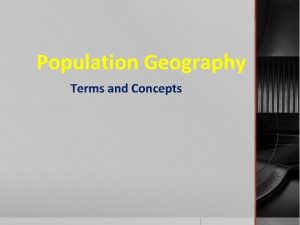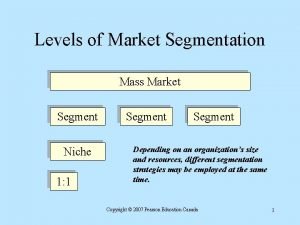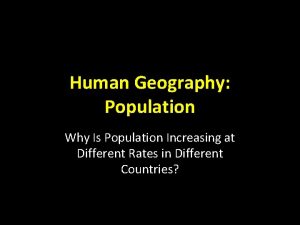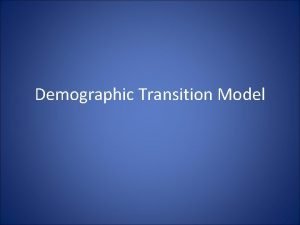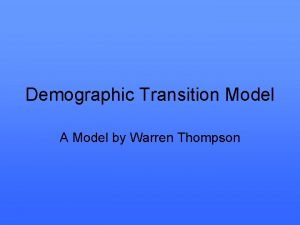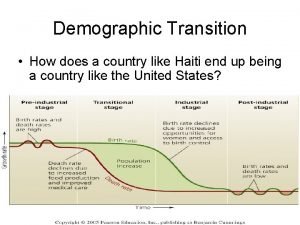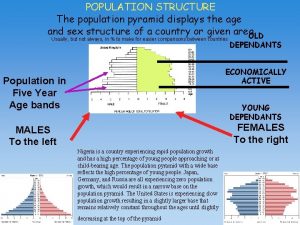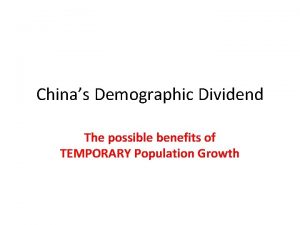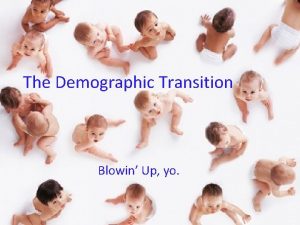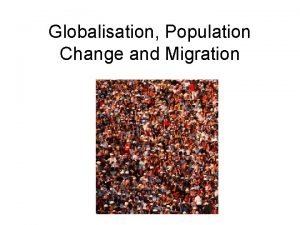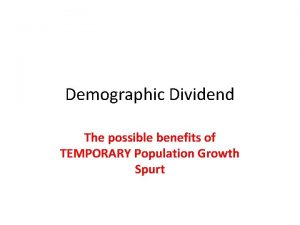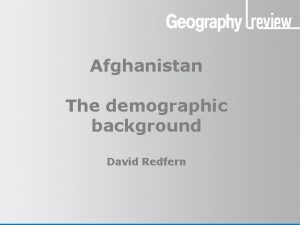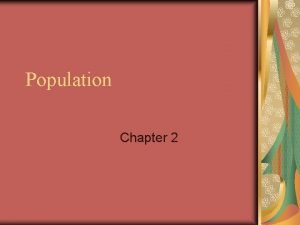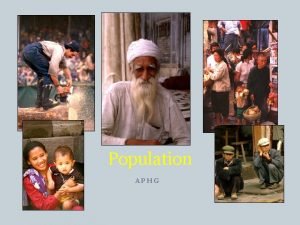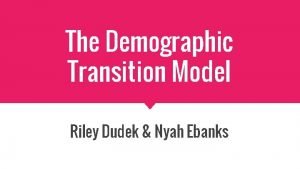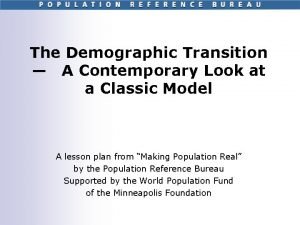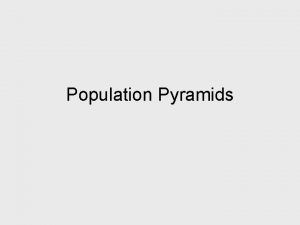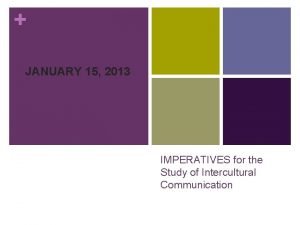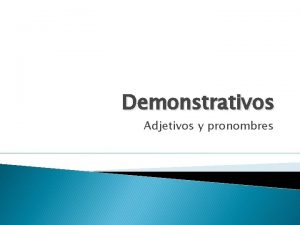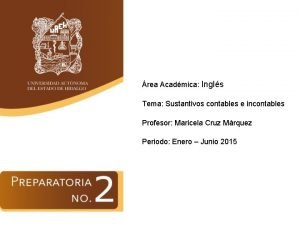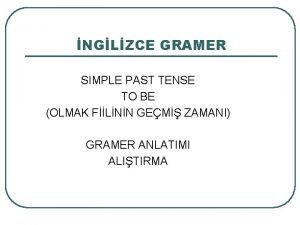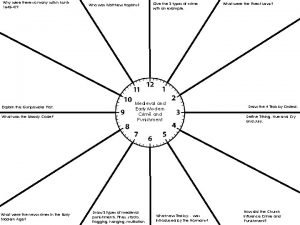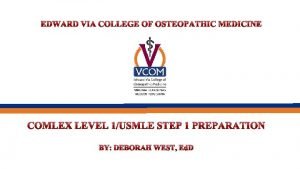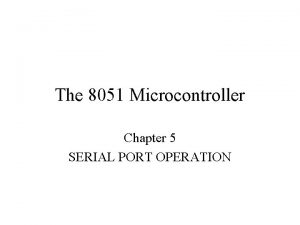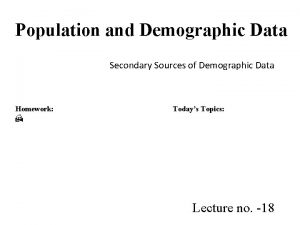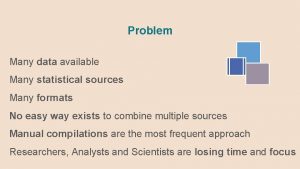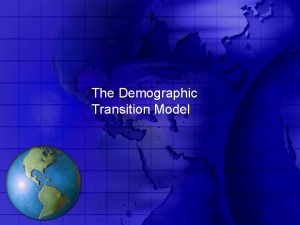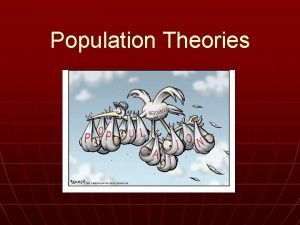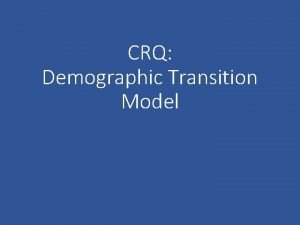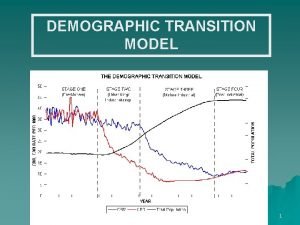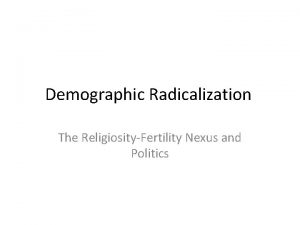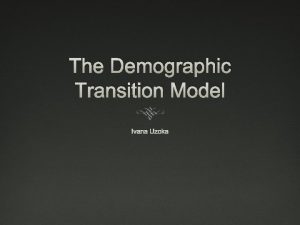SOURCES OF DEMOGRAPHIC DATA There are many data

















































































- Slides: 81

SOURCES OF DEMOGRAPHIC DATA • There are many data collection methods that different countries rely on. However, there are 3 major methods of data collection and these are: 1) Population Census 2) Sample Surveys 3) Vital Registration systems

SOURCES OF DEMOGRAPHIC DATA • In Uganda, the population census is the main source of data collection while in developed countries vital registration systems are commonly used. • There are other methods of data collection and these include; Dual records, Village studies and Population registers which are normally used in developed countries.

POPULATION CENSUS • The UN defines Census as the process of collecting, compiling and publishing demographic social and economic data pertaining all persons in a particular area at a particular point of time. A census is the biggest and oldest data collection method. • Census data taking had its beginning in the ancient times in Egypt, China, Palestine and Rome.

POPULATION CENSUS Cont’d • A few results of such censuses have survived to date and these population counts were undertaken primarily to determine physical labor force, military potentials or publications. • They were usually limited to house hold heads mainly the males of military age, tax payers & adult citizens. Women and children were excluded from such counts.

POPULATION CENSUS • During the 19 th Century, the focus of population censuses widened to include other administrative needs e. g. education, mortality e. t. c • The UN Criteria for modern population census include: ü Government Sponsorship ü Defined territory ü Defined period of time

POPULATION CENSUS ü Simultaneity (Simultaneous counting) ü Universality ü Individual unit of enumeration ü Processing and Publication of results

POPULATION CENSUS 1) Government Sponsorship (Legal Basis) • A census must have government sponsorship since it’s a big task and a vast elaboration that necessitates a machinery to carry it out. This is in terms of logistical requirements e. g. allowances for enumerators, paper work, transport e. t. c

POPULATION CENSUS 2) Defined Territory • The country must be demarcated in sub units which belong to that country and these sub units are referred to as enumeration units/areas. • Secondly, its only the government which can make a law to make people compliant in providing information

POPULATION CENSUS • The main purpose of defining territory is to make work easier and get clear limits

POPULATION CENSUS 3) Simultaneity (Simultaneous counting) • This criteria/procedure implies that enumerators should take place at the same time in all areas of the country where the population exercise is taking place. The reason for this is to minimize and avoid double counting since in most countries in Africa double counting is still a serious challenge

POPULATION CENSUS 4) Defined Period of time • It is important to define the period between one census and the next census i. e. called inter censual periods (this normally is after ten years). • Also important to note is to define the period when the census will be accomplished.

POPULATION CENSUS 5) Universality • It is very important to note that the census must include every person in a designated area without omitting any body and ensuring that no one is counted twice. This principle asserts that the census should include every body regardless of sex, age, race, nationality, religion, social status, economic status, ethnicity e. t. c

POPULATION CENSUS 6) Individual Units of Enumeration • While conducting the census each individual within the house hold must be counted not as part of the house hold but as an individual. This implies that every person is counted as an individual and not as a house hold unit.

POPULATION CENSUS 7) Processing and Publication of Results • It should be recalled that the main purpose of the population census is to plan for a particular country. Therefore, there must be a plan to publish the census results and because of that the results must be processed, analyzed and published. This process should be quick because of the need for results to guide planning and policy making.

TYPES OF CENSUS • There are mainly two types of censuses i. e. a) Defacto census b) Dejure census q Defacto Census • This involves counting of people according to where they are found at the time of the census i. e. the person is counted where he/she is found at the time of the census night.

TYPES OF CENSUS • Defacto count=Present Resident+Visitors • It is expressed in the formula below: Dc=PR+V Advantages of Defacto Census ü It is simple and less ambiguous ü It is time saving ü The problem of defining residents is avoided ü There are less chances of omissions and errors

TYPES OF CENSUS • Disadvantages of Defacto census ü The major disadvantage of this method is a floating population. This pauses a danger of counting and taking a floating population to be the actual population since visitors are also included

TYPES OF CENSUS q Dejure Census • This involves counting people who normally reside in a household/ an area. Therefore in this case people who usually reside in a given area are counted including those who are not present • Dejure=PR+AR-V i. e. Present Residents+Absent Residents-Visitors

TYPES OF CENSUS • Advantages of Dejure counting ü It is very appropriate for administrative purposes e. g. taxation, demarcation of political boundaries e. t. c ü Developed countries use dejure for locating residents • Disadvantages of Dejure census ü There is a high risk of omission since you depend on people’s memories

TYPES OF CENSUS ü There are high chances of double counting. It should be noted that in developing countries like Uganda, Defacto census is the most used because it is simple and easy to understand. However, developed countries prefer Dejure counting since it helps them in administrative planning

TYPES OF CENSUS • It is vital to note that the methods used depend on various factors e. g. how much money a country has, the needs of the data, technical competence e. t. c.

Common Questions During Census ü Names of members of the house hold ü The relationship of members of the house hold to the head of the house hold ü Age in complete years ü Migration and birth rate ü Sex ü Level of education ü Marital status

Common Questions During Census ü Level of income and occupation ü Religion ü Tribe e. t. c • The above listed are general questions that are commonly used world wide while conducting a census. However, some countries may use specific questions that might be vital and relevant to their set up and these may not apply to other countries

MAJOR STAGES INVOLVED IN CENSUS EXERCISE • Vital to note is that care must be taken while conducting a census in terms of planning. This is intended to avoid unnecessary costs and delays to the determination of the census results. There are various stages that include the following:

MAJOR STAGES INVOLVED IN CENSUS EXERCISE 1. Getting a Legal Basis for the Census • This involves ensuring public cooperation. This is because it is only the government that can compel people to cooperate or else people will not release the information needed. Therefore it is very much important to create a legal ground first that will formalize the census exercise.

MAJOR STAGES INVOLVED IN CENSUS EXERCISE 2) Making the Budget and Cost Control Measures • This is done so that all the costs at each stage are included and estimated taking into consideration the duration of each stage for pre and post enumeration period. This enables a country to overcome budget deficits, planning short falls and unwanted supplementary budgets.

MAJOR STAGES INVOLVED IN CENSUS EXERCISE 3) Administrative Organization • This is intended to include all government departments and other agencies that will benefit, use and refer to the census results e. g. the Ministry of Finance, Planning and Economic Development, Ministry of Health, other ministries, Donor countries, UN agencies e. t. c

MAJOR STAGES INVOLVED IN CENSUS EXERCISE 4) Communication Activities • This involves making the public aware of the census and publicizing the trend of the whole census exercise. This can be done through media (newspapers, TVs, radios), posters, seminars, internet e. t. c.

MAJOR STAGES INVOLVED IN CENSUS EXERCISE • The major purpose of communication activities is to remove fear and bias from the public so as to give a right course of the census, correct information and inform the public of the usefulness of the census.

MAJOR STAGES INVOLVED IN CENSUS EXERCISE 5) Cartographic/Mapping Work • The aim of this stage is to divide the country into small enumeration local zones so as to complete the coverage. Mapping is also intended to update the previous blocks. It should be noted that cartographic care must be taken by the surveyors and geographers so as to minimize subsequent errors.

MAJOR STAGES INVOLVED IN CENSUS EXERCISE 6) Listing of Living Quarters and Households • After cartographing has been made, there is a need to compile a list of living quarters and households. This is intended to estimate the number of enumerators needed for the work since it is based on the number of people to be counted and the number of households to be covered.

MAJOR STAGES INVOLVED IN CENSUS EXERCISE 7) Questionnaire Designing • This is done to determine the order of the interview, questions, the wording of the questions, the type of personnel needed to conduct interview, the methodology to be used in processing and analyzing data, the language to be used in the questionnaire e. t. c.

MAJOR STAGES INVOLVED IN CENSUS EXERCISE • It is very important to make orderly arrangement of questions to be used. Under this stage its also vital to emphasize proper translation of English questions

MAJOR STAGES INVOLVED IN CENSUS EXERCISE 8) Pilot Testing of the Questionnaire • This is done to check the relevancy of the questions to be used, instructions to be followed, wording of the questions, content of the questions, consistency of the instructions of the questionnaire and the applicability of these questions. This is intended to ascertain whether the questions will bring out the desired outcomes.

MAJOR STAGES INVOLVED IN CENSUS EXERCISE 9) Plan of Enumeration • It is important to plan before the census starts for the methods and homes that should be covered by one enumerator. It is important to lay out various procedures to control the quality of the data to be collected. This will ease data collection process.

MAJOR STAGES INVOLVED IN CENSUS EXERCISE 10) Plan for Data Processing • It is also important to plan for data processing and other issues like personnel to be used in data processing, the amount of space for the offices to be used, a coding system to be used and methods of data analysis.

MAJOR STAGES INVOLVED IN CENSUS EXERCISE 11) Staff Recruitment and Training • This is also a crucial step to be followed since a poor and low quality staff might challenge the outcome of the results. There is a need to recruit reliable enumerators and supervisors and thereafter give them the necessary skills through training.

MAJOR STAGES INVOLVED IN CENSUS EXERCISE • The main purpose is to enable them understand what the census is all about and equip them with necessary skills to get reliable results.

MAJOR STAGES INVOLVED IN CENSUS EXERCISE 12) Data Processing and Analysis • This comes after data collection. It involves coding, tabulation, processing, analysis and finally generating census data for future publication and use. 13) Publication of Results • This is done to inform the public about the census results from the analyzed data, reports from the analyzed data, tables summaries e. t. c

MAJOR STAGES INVOLVED IN CENSUS EXERCISE • It should be noted that census data should not be kept in shelves because it for the public cause. Publications can either appear on radios, newspapers, notice boards, internet and TVs. 14) Post Enumeration Surveys • These are surveys carried out after the census. The aim is to evaluate the quality and content of census results (validation of census results).

MAJOR STAGES INVOLVED IN CENSUS EXERCISE • However, post enumeration surveys are not always done because of the financial constraints.

Advantages of Census Method 1) Census data can be interpreted and used for planning purposes 2) A census is universal because it includes all people regardless of age, sex, tribe, religion, e. t. c unlike sample surveys which collect information from a fraction of the entire population 3) Simultaneous counting during census obtains the required information at ago.

Advantages of Census Method 4) Since it is a government requirement, it involves all people and compel them to give results and this helps to get detailed and comprehensive information that can be used for government purposes

Limitations of Census 1) The period between censuses is too long (10 years). It should be noted that many events take place and are not recorded e. g. from 2002 to 2014 for instance the projection for 1991 census was 20 million people but it slowed down to 16. 8 million. Reasons for this were; HIV, guerilla war (1981 -1986), expulsion of Rwandans e. t. c.

Limitations of Census 2) Census method is very expensive e. g. the 2002 census cost Uganda 36 billion shillings. Yet Uganda is a developing and has to be supported by the donors. 3) People who are not always present at their places of residence might increase nonresponse errors in the data.

Limitations of Census 4) It is hard to carry out a census in areas affected by war, internal conflicts, natural disasters e. t. c 5) Most enumerators for population census are not experienced compared to those of sample surveys. Being a large population many people are recruited and trained for a shortest period of time and doing so they don’t become professional interviewers.

Limitations of Census 6) Since it involves many people because of its requirements there are many response errors in coverage and content. 7) Data analysis takes along time e. g. on average it takes two and a half years which is too long. 8) Since it is universal, it can affect other government programmes and work

SAMPLE SURVEYS • Sample surveys are studies that cover relatively a larger percentage of the population and they are carried out for specific topics. Surveys seek to collect information from a fraction of the entire population. It should be noted that unlike population census the history of demographic sample surveys as a source of data is relatively recent in Africa.

SAMPLE SURVEYS • Sample surveys are used to achieve results on selected demographic characteristics from the entire population e. g. fertility, health, migration and mortality trends. • In Uganda, surveys are the second most important source of generating demographic data after census. However, they were invented in USA in 1930 s

SAMPLE SURVEYS where they selected a few areas and generated results to represent the entire population.

Types of Sample Surveys 1) Small Scale and Large Scale Surveys • Small scale surveys include less that 5000 people while large scale surveys cover more than 5000 people e. g. the Uganda Demographic Health Survey that is carried out every after 4 years.

Types of Sample Surveys 2) Census Type Inquiries and Retrospective Surveys • Census type inquiries ask questions that are similar to census questions and sometimes they can substitute censuses e. g. post enumeration surveys. On the other hand retrospective surveys ask questions about events that happened in the past

Types of Sample Surveys 3) Single round and Multi round Surveys • Single round surveys are carried out only once and multi round surveys involve repeated visits where the same questionnaire is applied. • Single round surveys have a high level of omissions and reporting errors and the disadvantage with multi round surveys is that they are very expensive because they involve repeated visits.

Types of Sample Surveys • In single round surveys the enumerator makes a single visit to the house hold and in multi round surveys the enumerator carries out the first visit to the house hold and prepares a list of people to be surveyed as a sample and then the sample is selected in the first round and is visited for may times. This might take an interval of 3 to 6 months e. g. the Uganda Budget House Hold Surveys.

Types of Sample Surveys 4) The Dual Record System • This is based on collection of data from a selected sample using two independent operations i. e. multi round surveys and registration. • In multi round surveys operations, visits are made within the sample at fixed intervals of 3 to 6 months.

Types of Sample Surveys • In registration operations, a registrar is nominated from within a community itself to report all the vital events occurring to the selected sample on a monthly basis. Afterwards, the results from the 2 operations are matched event by event.

Differences Between Sample Surveys and Population Census 1) A census has wider objectives while surveys are always specific 2)Censuses are undertaken by national governments while sample surveys can be carried out by institutions, individuals and organizations 3) A Complete and comprehensive survey can serve the purposes similar to a census and if it is partially done it remains a sample survey

Differences Between Sample Surveys and Population Census 4) A census is inclusive(it involves all people) while a survey is exclusive since it involves a sample of the entire population 5) Demographic sample surveys can be part of the census. This is through the post enumeration sample surveys to check on the content quality of the census data

Differences Between Sample Surveys and Population Census and can be done to collect more information to fill the gaps which were left out during the census exercise. However, a census cannot be part of the sample survey.

Advantages of Sample Survey Method 1) It is relatively cheaper compared to the census because it involves a few numbers of the population 2) If the sample surveys are well conducted, they can generate quality and more detailed data. 3) The short interval of a sample survey makes it a better method in studying population growth, characteristics of the population e. t. c

Advantages of Sample Survey Method e. g. employment, mortality rates e. t. c. It should be noted that these characteristics change frequently 4) Demographic surveys can be used to test the accuracy of the census data and can help to record vital statistical information from the census results e. g. post enumeration data.

Advantages of Sample Survey Method 5) We can be able to experiment on new questions and be able to rectify them within a short period of time as compared to the census where the interval between the first and next census is long (roughly ten years) which might not generate any experiment.

Limitations of Sample Surveys 1) The data collected is usually insufficient to meet the heavy demand for the information 2) Surveys have a high likelihood of sampling and non sampling errors and omissions. This is because of some methodological approaches that are used to generate data. 3) If the informants in the sample don’t cooperate with interviewers, the survey won’t give accurate results

Limitations of Sample Surveys 4) Survey data may not be a representation of the characteristics of the entire population. This is because it involves selection of a sample for which the results will be generalized. Therefore it becomes unrealistic to make conclusions by generalizing the whole population.

Limitations of Sample Surveys 5) Sample surveys require attentive supervision during field work and as such they should be handled by experienced and professional interviewers while collecting data. 6) Sample surveys are very expensive as compared to other methods in terms of hiring professionals and getting in-depth information.

VITAL/CIVIL REGISTRATION SYSTEMS • This method involves a continuous recording, compiling and analysis of vital events pertaining to a population over a specific period of time e. g. a year, month e. t. c. • It should be recalled that vital comes from Latin word “Vita” which means life. A very important element to note here is that there must be a continuous recording of events under the vital registration systems.

VITAL/CIVIL REGISTRATION SYSTEMS • Important items recorded are; birth, death, migration, marriage, divorce, and other vital statistical issues. It should be noted that registration is done by the registry e. g. a town, municipality or city council. • Vital registration systems are very common in developed countries and they started in England in 1593 where vital events were recorded by the Church of England

VITAL/CIVIL REGISTRATION SYSTEMS e. g. on baptism and burials as a result of this it became compulsory that all people had to be registered under the new church of England. This trend continued and by 1842 things changed and civil registration systems started e. g. registration of birth, death e. t. c • With the appointment of the registrar general, this process spread all over Europe and other developed countries.

Types of Vital Registration Systems 1) Passive Registration 2) Active Registration 3) Semi Active Registration q. Passive Registration • The population records events at the registrar’s office e. g. when you give birth or lose some one, you report to the registrar’s office.

Types of Vital Registration Systems q. Active Registration The registrar and other government personnel go out to look for people to register events e. g. death, birth, migration e. t. c. This is normally backed up by the legal system (law).

Types of Vital Registration Systems q. Semi Active Registration Under this type of vital registration, the government relies on institutions e. g. church, hospitals, schools, e. t. c to record events like death, birth, marriage, education, migration and send the information to the government offices

Importance of Vital Registration Data • It is used for administrative purposes e. g. monitoring death (its causes, number of death e. t. c) migration control measures, issuing of certificates , monitoring birth rates e. t. c • Since it is a continuous process, it presents lower costs • It is likely to generate quality data. This is possible if all events are registered promptly and accurately.

Importance of Vital Registration Data • It studies particular events in-depth because it targets particular and more specific issues • It helps for planning purposes especially scenario planning. This helps a country to be alert on demographic issues e. g. migration, death, fertility rates among women, fecundity rates e. t. c

Importance of Vital Registration Data • Vital registration systems can be used for validations. It can validate census results or data from sample surveys.

VILLAGE STUDIES • These were developed by James Caldwell and are mainly anthropological in nature. Village studies involve participant observation, interviewing and documentary review. It is important that the village to be studied be purposely selected and studied in-depth. These studies are mainly qualitative in nature and very descriptive i. e. understanding intensively people’s behavior in particular communities

POPULATION REGISTER • This is another secondary source of collecting population data. It is mostly used by European and Asian countries e. g. Belgium, Sweden, Korea, Israel, e. t. c. These countries contain the use of population registers and maintain their legality because they use them for administrative and legal purposes. Population registers contain names, age, address among other information for every citizen in that particular country.

POPULATION REGISTER • The register has information on citizens that have migrated out to other countries, those who enter the country e. t. c) • It is vital to note that the major purposes of population registers is to verify the correctness of census figures and statistics

OTHER RECORDS • These are also other sources of demographic data and they are secondary methods of data collection. They maintain population records to meet social security schemes e. g. unemployment, insurance, pension, maternity allowance e. t. c • In some countries, insurance companies maintain life tables containing the birth and death trends.

OTHER RECORDS • Selective demographic data are also available from electoral lists, income tax payers lists, telecommunication subscribers lists, criminal investigation lists, banking lists e. t. c • Though such administrative data is limited, it is helpful in providing demographic data that can be useful for planning purposes.

INTERNATIONAL PUBLICATIONS • Other sources of demographic data for the world and different countries are the United Nations Demographic Year Book and Statistical Year Book. Some International agencies like WHO publish monthly epidemiological journals and vital records which give data on public health and mortality of different countries.

INTERNATIONAL PUBLICATIONS • Also the UNDP in its Human Development Reports and the World Bank in its World Development Reports publish annually demographic data relating to population growth, health of the population, population projections, fertility and mortality rates of countries and implication of such statistical data for development planning purposes.
 Antigentest åre
Antigentest åre Sources of demography ppt
Sources of demography ppt Print sources of information
Print sources of information Important of water management
Important of water management Population demography definition
Population demography definition Data collection secondary data sources
Data collection secondary data sources Carrying capacity ap human geography
Carrying capacity ap human geography Uk demographic transition model
Uk demographic transition model Epidemiological transition
Epidemiological transition Tesla target market
Tesla target market Boserup
Boserup Demographic momentum ap human geography definition
Demographic momentum ap human geography definition Demographic transition theory
Demographic transition theory Galapagos
Galapagos Market segmentation geographic demographic psychographic
Market segmentation geographic demographic psychographic Mass market segmentation
Mass market segmentation Demographic transition model ap human geography
Demographic transition model ap human geography Demographic parity
Demographic parity Demographic transition model
Demographic transition model Demographic transition theory by warren thompson
Demographic transition theory by warren thompson Haiti demographic transition model
Haiti demographic transition model Theory of demographic transition
Theory of demographic transition Tesco demographic segmentation
Tesco demographic segmentation Demographic transition model ap human geography definition
Demographic transition model ap human geography definition Un demographic yearbook
Un demographic yearbook Luxury consumer demographics
Luxury consumer demographics Brown pringles
Brown pringles Population pyramid stage 1
Population pyramid stage 1 Demographic transition model worksheet
Demographic transition model worksheet Recent demographic changes in the uk
Recent demographic changes in the uk Demographic dividend china
Demographic dividend china Two big breaks in the demographic transition
Two big breaks in the demographic transition Demographic transition model song
Demographic transition model song Starbucks demographic segmentation
Starbucks demographic segmentation Workforce and demographic trends in hrm
Workforce and demographic trends in hrm Where are the holes in the ozone layer located
Where are the holes in the ozone layer located Demographic transition
Demographic transition Demographic dividend philippines
Demographic dividend philippines Demographic dimensions of consumer market
Demographic dimensions of consumer market Afghanistan dtm stage
Afghanistan dtm stage Demographic transition def
Demographic transition def Epidemiological transition model stage 2
Epidemiological transition model stage 2 Biohacking market demographic
Biohacking market demographic Demographic momentum ap human geography definition
Demographic momentum ap human geography definition Bts fan age demographic 2020
Bts fan age demographic 2020 Demographic transition model example
Demographic transition model example Demographic transition model
Demographic transition model Demographic profile in statement of the problem
Demographic profile in statement of the problem Italy demographic pyramid
Italy demographic pyramid Demographic imperative intercultural communication
Demographic imperative intercultural communication There is there are ejemplos
There is there are ejemplos What part of speech is open
What part of speech is open There is there are negative form
There is there are negative form Countable and uncountable there is there are
Countable and uncountable there is there are Some or any bananas
Some or any bananas There is there are
There is there are All of the cds even the scratched one (is are) in this case
All of the cds even the scratched one (is are) in this case Adjetivos demonstrativos
Adjetivos demonstrativos A any some правило
A any some правило Contables e incontables
Contables e incontables Pep unit
Pep unit Ingilizce gramer zamanlar tablosu
Ingilizce gramer zamanlar tablosu There is there are exercises
There is there are exercises There is there are
There is there are Hayis
Hayis There's and there are
There's and there are If there is no struggle there is no progress examples
If there is no struggle there is no progress examples Work energy theorem formula
Work energy theorem formula Why were there so many witch hunts 1645-47
Why were there so many witch hunts 1645-47 Secondary consumer
Secondary consumer Greek words for love
Greek words for love How many types of engineering are there
How many types of engineering are there Step 1 break time
Step 1 break time Cordilleran vegetation
Cordilleran vegetation How many colours are there
How many colours are there How many types of sentences are there
How many types of sentences are there Different formal letters
Different formal letters How many different rocks are there
How many different rocks are there 6 basic mother sauces
6 basic mother sauces Layers of the earth's crust
Layers of the earth's crust What are the sins against the holy spirit
What are the sins against the holy spirit Serial port in 8051 microcontroller
Serial port in 8051 microcontroller




